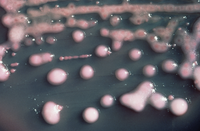
Photo from wikipedia
The emergence and dissemination of NDM-1 (New Delhi metallo-β-lactamase-1)-producing Enterobacteriaceae have resulted in a worldwide public health risk. This study described a high incidence and endemic spread of NDM-1-producing extensively… Click to show full abstract
The emergence and dissemination of NDM-1 (New Delhi metallo-β-lactamase-1)-producing Enterobacteriaceae have resulted in a worldwide public health risk. This study described a high incidence and endemic spread of NDM-1-producing extensively drug-resistant Escherichia coli in a teaching hospital in Zhejiang province, China. We recovered six nonduplicated NDM-1-producing E. coli isolates from May 2014 to August 2014 with positive modified Hodge test and EDTA synergistic test. These isolates were highly resistant to β-lactam antimicrobials, aminoglycosides, and quinolones. PCR and DNA sequences analysis showed that all isolates carried the blaNDM-1, blaSHV-11, aac(6')-ib-cr, and qnrB. Several isolates also harbored blaCTX-M-1, blaCTX-M-9, rmtB, and qnrA. Southern blot confirmed that blaNDM-1 was located on the same ∼55 kb plasmid and conjugation experiments further proved the contransferable characteristic of blaNDM-1. The ompC sequences showed various mutations, which was related to multidrug resistance in E. coli. Pulsed-field gel electrophoresis identified four of six isolates that belonged to the same genotype. Multilocus sequence typing assigned them to ST2, except one strain that belonged to ST594. Our study demonstrated that the resistance-associated genes and the loss of the outer membrane proteins could account for high resistance of NDM-1-producing E. coli to multiple antimicrobial drugs. Both horizontal transfer of IncN and transmission of ST2 were responsible for the spread of drug resistance. These findings highlighted an urgent need to limit the further dissemination of NDM-1-producing E. coli in this region.
Journal Title: Microbial drug resistance
Year Published: 2017
Link to full text (if available)
Share on Social Media: Sign Up to like & get
recommendations!